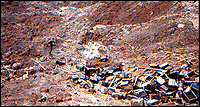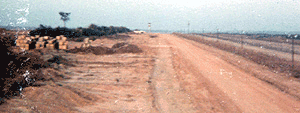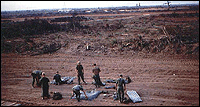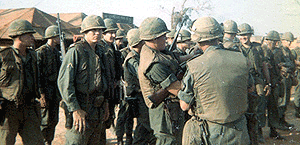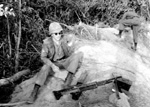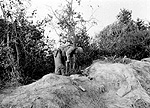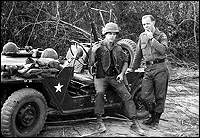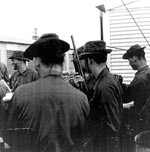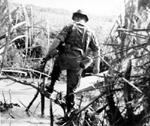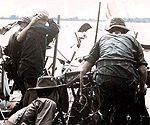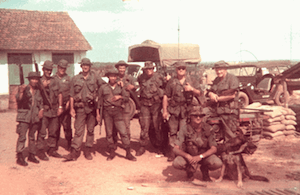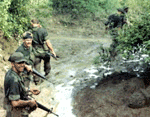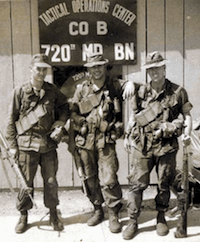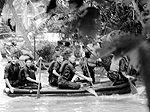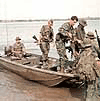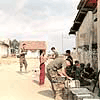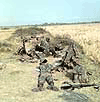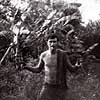|
B Company, Joint Reconnaissance Team at the Old French Fort on the Dong Nai River. |
|
A Company, PFC Rutherford, SP/4 Durden and unidentified MP at Outpost-4. |
|
A Company, SGT Pete Dedijer and SP/4 Chuck Edwards at Outpost-4. |
|
A Company, PFC Rutherford, SP/4 Durden, SP/4 Edwards and two unidentified MPs at Long Binh Tan. |
|
A Company, PFC Henslee, SP/4 Durden, unidentified MP and two PF's. |
|
A Company, SP/4 West and unidentified partner on day recon. |
|
B Company, Ambush Squad, SGT Hall, PF Muon, PFC Sellock, SP/4 Zavilla. |
|
SGT Hartwig, SP/4's Zavilla, Reedy, and Duttola, in An Xuan Village. |
|
B Company-CPL "Woody" Morgan Squad Leader of Ambush Squad-76 at Outpost-2, Long Hung, April. |
|
B Company, Ambush Squad-76. |
|
A Company, Ambush Squad. |
|
B Company, Ambush Squad-74 at the "Duck Farm." |
|
B Company-SP/4 Green & unidentified Ambush Team member in the field. |
|
B Company, Ambush Squad-76. |
|
Ambush Squad at Outpost-4. |
|
Enemy Weapons captured by B Company Ambush Squads 23 February. |
|
Enemy Weapons captured by B Company Ambush Squads 23 February. |
|
B Company, Ambush Squad-76. |
|
A Company, SP/4 Hensley and unidentified MP on a day recon patrol in Long Binh Tan. |
|
A Company, PFC Diaz followed by SP/4's Martin, West, and Durden, on day recon patrol in TAOR. |
|
B Company, SGT Hartwig, his RTO and a Scout Dog & Handler from the 212th on a recon. |
|
B Company, SGT Hartwig, PFC's Green, Kreidler and a CPL Fuller of the 212th on a recon. |
|
B Company, SGT Hartwig, PFC Green, and CPL Fuller of the 212th on a recon. |
|
B Company, SP/4 Frank B. Scellato, Audrey “Dale” Bolen and others unidentified. |
|
B Company, CPL Watson and others on the bank of the Dong Nai River. |
|
B Company, SP/4 Scellato & CPL Watson and others on the bank of the Dong Nai River. |
|
B Company, 18th MP Brigade helicopter deliveres supplies in the TAOR. |
|
B Company, River Patrol Whaler's arrive on the Dong Nai. |
|
B Company, Ambush Squad-76. |
The last major battle occurred along the berm of the rifle range on Highway-317 in the early morning just after daylight. Ambush Squad-75, held in reserve throughout the night, was assigned to conduct a sweep of the tree line where the post perimeter had received heavy enemy fire from during the early morning attack. As the squad approached a small crest by the rifle range, they came under an immediate rain of grenades, automatic weapons fire and rocket propelled grenades from an entrenched enemy platoon hidden in the top of the berm. Although at first overwhelmed by the intensity of the enemy onslaught and suffering casualties, they stood their ground, suppressed the enemy fire, eliminated an enemy machine gun emplacement and were able to evacuate their seriously wounded point man. When a Troop of tanks and APC of the 11th Armored Cavalry Regiment that came to their support was stopped by the intensity of the enemy fire, several Cobra gunship's were brought into the attack the enemy position was finally silenced and 23 enemy dead were discovered.
Another Troop of the 11th Armored Cavalry Regiment was called in to assist Ambush Squads 74,77 and 78 with a sweep and clear operation (east to west) across the Finger of Land. The sweep resulted in one Trooper wounded in action, and the death and capture of another platoon of enemy.
By mid-day, a total of 131 enemy bodies were recovered from the combined battle fields. The few enemy soldiers that did penetrate the post perimeter were killed or captured by members of the A & C Company, Battalion Post Reaction Force, perimeter bunker guards and supporting infantry units called in to assist.
During the attack seven U.S. soldiers stationed on Long Binh Post were killed in action, and thirty wounded. Available records indicated that most of the killed and wounded resulted from the approximately seventy-eight rounds of rocket and mortar fire that impacted inside the post during the initial attack.
Given their precarious assignments, B Company casualties were light with only four wounded. A Company suffered three wounded by RPG fire inside the post during perimeter defense.
The B Company Ambush Squads and 212th MP Company Scout Dog Unit MPs involved in the fighting were credited with breaking the back of the enemy attack and later individually awarded two Silver Stars, approximately two dozen Bronze Stars for Valor and four Purple Hearts, yet the company as a whole was never formally recognized by Battalion, Group or the Brigade for its valor.
|
|
Ambush Squad-73, Outside Gate #11, yet to be identified. |
|
Ambush Squads-75 and 77. |
|
Ambush Squad-79. |
|
Ambush Squad-77. |
|
Ambush Squad-78 at the Rice Mill by the Steel Bridge. |
|
Unidentified ambush team in An Hoa Hung Village. |
|
April, Ambush Squad-77. |
|
August, Ambush Squad-77. |
|
SP/4 Alfano , B Company and SP/4 Gates of the 212th Scout Dog Unit and his K9. |
|
March, Ambush Squad-78. |
|
Map of TAOR used by Ambush Squad-78. |
|
SP/4 Aurillo stuck in the mud. |
|
Miller, Edward A. Santry, Brownie, Ed Aldrich, SGT Slaughter, Pete Hernandez, Gabby and unknown. |
|
Grant, Hernandez, SP/4 Takenalive, Gonzalez, SGT Slaughter, and others Unidentified. |
|
1st Platoon (Ambush) group photo on the Finger Of Land. |
|
SGT Slaughter and a Vietnamese Interpreter. |
|
SP/4 Marley and SSG Thomas on ambush. |
|
SP/4's Perry and Radcliff on ambush. |
|
SSG Meador in the TAOR. |
|
Ambush Squad in the TAOR. |
|
SSG Darreld E. Fisher. |
|
SP/5 Bogison, SP/4's Ward, Barman, Thompson, Main, Ratcliff, Perry, on ambush mission. |
| G0151 |
Ambush Squad-75. |
|
SP/5 Robert Bogison, SP/4's Ward, Lewin, Bischoff, "Gomer," Palmateer, and Cortez. |
|
SP/5 Bogison, SP/4's Lewin, Ward, Palmateer, Cortez, Golanski, Pasmino and "Gomer." |
|
Ambush Squad, SGT Torres and others yet identified. |
| G1570 |
Ambush Guard Mount. |
|
The last day of ambush and recon. |
|
SP/4 Ed "Shakey" Marley. |
|
March: Weapons, ammunition, supplies recovered from VC Base Camp on back river. |
|
SP/4 Bill Parker on a PBR. |
|
SP/4 Galonski cooking C Rats on a mission. |
|
SP/4's Radcliff, Ward and two unidentified on a PBR. |
|
SP/4 Mike Ambrose on ambush. |






